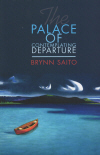The Palace of Contemplating Departure
In her debut collection, The Palace of Contemplating Departure, Brynn Saito carries uncertainties and measures them out against the known and the unknown. Saito finds an enthralling voice for complex emotions about race, war, identity, scars, ghosts, family, and suffering. Her undeniable cultural identity is woven through the poems. Her parents are Japanese American and Korean American; their stories, of life during a time when being Asian was a liability in America, are retold here, while Saito’s own stories predominate throughout. She lets us get to know her in an equivocal way and then leaves us with a light hold of attachment and a fierce curiosity about meaning and significance.
In her debut collection, The Palace of Contemplating Departure, Brynn Saito carries uncertainties and measures them out against the known and the unknown. Saito finds an enthralling voice for complex emotions about race, war, identity, scars, ghosts, family, and suffering. Her undeniable cultural identity is woven through the poems. Her parents are Japanese American and Korean American; their stories, of life during a time when being Asian was a liability in America, are retold here, while Saito’s own stories predominate throughout. She lets us get to know her in an equivocal way and then leaves us with a light hold of attachment and a fierce curiosity about meaning and significance.
The Palace of Contemplating Departure is an apt title for the tone of experience she renders in her poems. There are multiple layers of the theme of departing: leaving places, people, life, or attachments. There is a constant awareness of impermanence, the temporary and moveable, and how we cannot control what is changed or lost. Beauty as power: the beauty of the world so powerful that she is afraid to let it go, yet she seeks beauty over and over, along with love and the ability to let go. From “Autumn in the Garden with her Ghost”:
. . . I said, “I’m afraid
to let go of the world.”
She lifted a black stone
from the shallow pond
and palmed it–You think
that I’m asking
for you to renounce it.
I said, “I believe
that beauty is power.
Look how the ash tree
catches the light;
look at the jasmine.”
Occasionally a poem feels like scattershot of language when it ventures too far into the abstract and there is nothing there to tether us. However, some of those abstractions strike me as more than adequately intriguing: “. . . I learned something about / the beautiful blue vein of seduction / that runs alongside everything deadly.”
The themes, the haunting voice, the “gathering mind” of Saito resonate strongly with Louise Gluck’s work—in particular, The Wild Iris. Like Gluck, she is able to imbue the natural world with emotion and human purpose, to let it speak with complexity about things that words cannot explain alone: “Returning to the sea is like returning to a grave that’s been shot through / with sunlight. The sea is so full, we begin to float.”
In the end it is hope, perhaps as a motivator for all the questions and searching, that fills the pages of this book. Contemplating departure is not the same as leaving, yet it allows for that possibility. The Palace of Contemplating Departure creates the place for that never-ending discussion of endings and beginnings, and gathers to mind a delicate, fierce journey.





